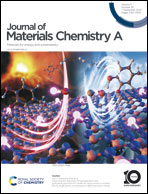A metal–organic framework based propylene nano-trap with dual functionalities for highly efficient propylene/propane separation†
Abstract
Propylene/propane (C3H6/C3H8) separation represents one of the most challenging and energy-intensive processes in the petrochemical industry due to their very similar sizes and physical properties. Most of the reported physisorbents still face the challenge of achieving simultaneously high C3H6 uptake and selectivity with moderate adsorption enthalpy. Herein, we realize an efficient propylene nano-trap in a microporous MOF (ZJUT-2, Ni(pyz-SH)2SiF6) for highly efficient C3H6/C3H8 separation. This MOF-based propylene nano-trap features a suitable pore cavity decorated with dual functionalities (–SH and SiF62−) to optimally interact with the C3H6 molecule, affording both large C3H6 capture capacity (123.5 cm3 cm−3 at 296 K and 0.5 bar) and high C3H6/C3H8 selectivity of 17.2 achieved with moderate C3H6 adsorption enthalpy (45 kJ mol−1). Theoretical calculations revealed that the appropriate pore cavity and dual functionalities synergistically construct an efficient nano-trap to match better with the C3H6 molecule and thus provide stronger multipoint interactions with C3H6 over C3H8. Actual breakthrough experiments demonstrated that this material can efficiently capture C3H6 from C3H6/C3H8 mixtures (50/50 and 10/90, v/v) under ambient conditions, affording both top-tier C3H6 capture amount (2.6 mmol g−1) and dynamic selectivity of 10.

- This article is part of the themed collection: Functional Framework Materials


 Please wait while we load your content...
Please wait while we load your content...